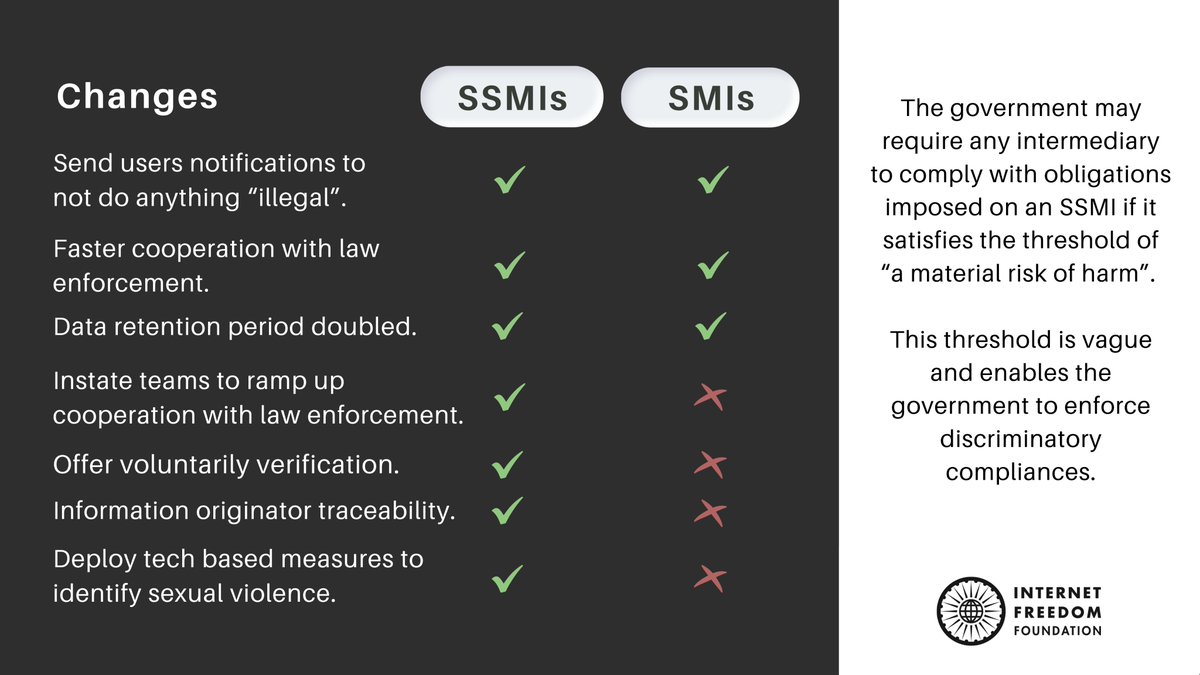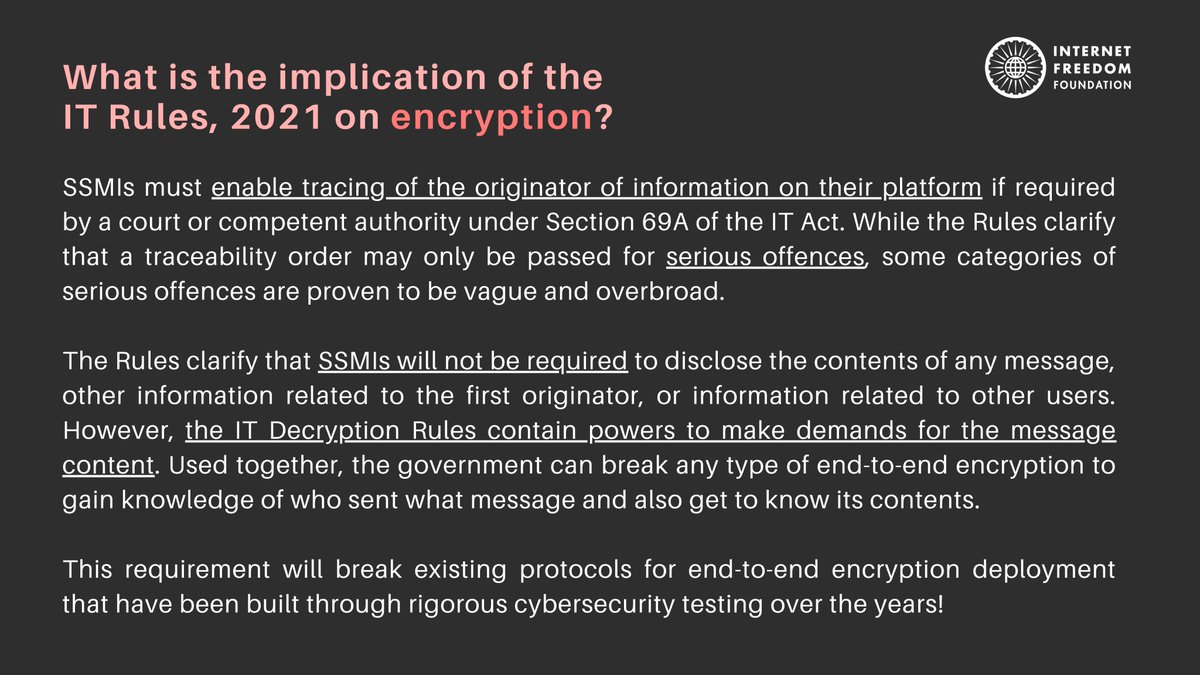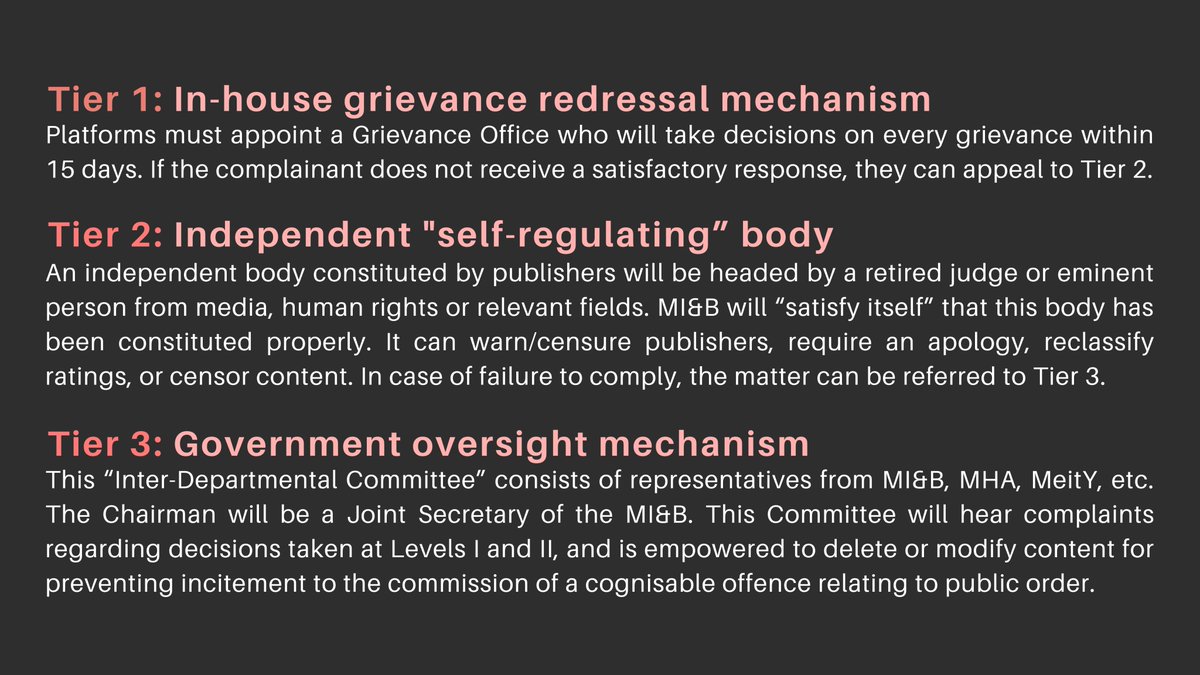
It's done: The IT Rules, 2021, are officially in play. We cannot stress this enough - this fundamentally changes the Indian internet. Please RT this thread on the Rules and how they bring government control over digital media like never before.
internetfreedom.in/intermediaries…
1/n
internetfreedom.in/intermediaries…
1/n
IT Rules affect social media, OTT, and news platforms. The latter 2 have been brought under the Rules for the first time. The Rules make platforms legally liable for not complying with government regulation, hence making user experience fall in line with the same.
2/n
2/n
Social media platforms with 50 lakh+ users will now be regulated as Significant Social Media Intermediaries (SSMIs) with different obligations than Social Media Intermediaries (SMIs). Government discretion in compliance can lead to discrimination which disempowers small SMIs.
3/n
3/n

SMIs are now more answerable to law enforcement, with lesser breathing space around compliance deadlines.
Content takedown after receiving orders: 36hrs
Providing info to law enforcement: 72hrs
Requests to remove sexual content: 24hrs
Redressal by grievance officers: 15 days
4/n
Content takedown after receiving orders: 36hrs
Providing info to law enforcement: 72hrs
Requests to remove sexual content: 24hrs
Redressal by grievance officers: 15 days
4/n
The data retention period for SMIs has been doubled to 6 months for investigative purposes. Data will be preserved even if accounts are deleted. We are challenging this in the Supreme Court because such data retention in the absence of a data protection law is dangerous.
5/n
5/n
SSMIs must allow voluntary verification which can be a slippery slope towards mandatory verification and destroy user anonymity.
Further, web services will now notify you at least once a year not to do anything “illegal” - get ready for lots of spam in your inbox.
6/n
Further, web services will now notify you at least once a year not to do anything “illegal” - get ready for lots of spam in your inbox.
6/n
SSMIs must enable tracing originators of info in case of serious offences. See this graphic on why this IS an end-to-end encryption issue despite not being presented as such.
They must also deploy tech to identify sexual violence content, which leads to function creep.
7/n
They must also deploy tech to identify sexual violence content, which leads to function creep.
7/n

Moving on to news media and OTT. Such platforms being regulated under the Rules amounts to the executive amending parliamentary legislation and is NOT permissible under the Constitution.
There is excessive delegation of powers - e.g. the government's “oversight committee”.
8/n
There is excessive delegation of powers - e.g. the government's “oversight committee”.
8/n
The Rules are applicable to all ‘news and current affairs content‘ regardless of the size of publication. Due to vague language, the Rules arguably could also seek to regulate all internet users who produce news, analysis, and socio-political commentary on a small scale.
9/n
9/n
News and OTT will adhere to a Code of Ethics via a 3-tier regulation mechanism. But the provisions of the Rules are too onerous for self-regulation to effectively happen. Platforms will be forced to self-censor keeping in mind overbroad restrictions.
10/n
10/n

MI&B will have emergency powers to block OTT and news content without any hearing. Tier 2 and 3 bodies have wide-ranging punitive powers.
The Rules state a loss of immunity with consequences including criminal prosecution in case of non-compliance for all intermediaries.
11/n
The Rules state a loss of immunity with consequences including criminal prosecution in case of non-compliance for all intermediaries.
11/n
We are appealing to you to engage with this issue because the Rules will change the internet as we know it. We invite you to let us know your thoughts, views and any corrections.
Please support us so that we can continue standing up for your rights!
internetfreedom.in/donate/
12/n
Please support us so that we can continue standing up for your rights!
internetfreedom.in/donate/
12/n
• • •
Missing some Tweet in this thread? You can try to
force a refresh







